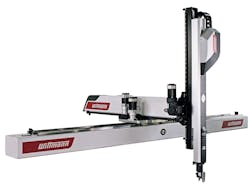Wittmann Battenfeld introduces, upgrades robots
By Bruce Geiselman
Wittmann Battenfeld recently launched U.S. sales of its latest Primus robot and upgraded a couple of existing robots.
“Even with all the chaos of the last year, we have continued to work as hard on improving our product line as always, and we have some really exciting product news to share with the industry, even without a trade show to do it at,” spokeswoman Crystal Gagnon said.
The new Primus 48T is the largest in the line, which is designed for pick-and-place applications. It has a telescoping arm, a payload capacity of 44 pounds and is designed to work with injection molding machines with clamping forces from 20 tons to 900 tons. The second-largest model is the 26T, which has a payload of 22 pounds. The 48T has a Z stroke of 8.2 feet to 19.7 feet, an X stroke of 2.6 feet to 3.9 feet, and a Y stroke of 5.2 feet to 6.6 feet.
In addition, Wittmann Battenfeld updated its Sonic Ultra high-speed robots to be more streamlined and efficient. The company said the new design will help the molded part-removal robots “last longer and maintain themselves through the wear and tear created by their impressive speeds.”
“The Sonic robots are designed for applications down to 4-second cycles,” National Sales Manager Jason Long said. “The new design takes the great features from our Pro robots, such as wider bearing stance and axis profiles, to ensure even at faster speeds, the drives stay cool for less wear. These robots also now come standard with a complete auto lubrication system for all bearings and rack and pinion to make them a very low maintenance robot even at ultra-high speeds.”
The company also added features to its R9 robot control system, which is used on most of its robots, including an updated Quick New Wizard programming function and new ergonomic vertical touch screen pendants.
“The new Quick New Wizard requires very little training for the operator and can have a robot up and running in just a few short minutes,” Long said. “The flexibility now allows for more than just a simple pick-and-place program. The end user can set up more complex programs for things like degating parts or stacking parts by just answering a few simple questions.”
Other additions to the R9 robot control system include a digital twin simulator to help users better simulate complex processes to more accurately predict their outcomes, the company said.
“The R9 new digital twin feature allows for a virtual display of real robot processes,” Long said. “Based on the robot programming, the R9 control generates a virtual production cell, and visualizations can be zoomed with freely selectable perspectives and altered at any time. The digital twin has the same attributes and characteristics as the real equipment, which enables simulation of the robot cycle. The digital twin can run on the R9 TeachBox and a PC. The programmer can run the cycle simulation before it is entered into the robot, allowing the user to catch possible errors at an early virtual stage.”
Other new features on the R9 controller include a “replay” troubleshooting feature, and the incorporation of new anti-collision features.
“The replay feature records all changes in positions, in/out points, counters, teach commands and all other values relevant to the operation,” Long said. An example of a practical application is a robot stopping for unknown reasons; users have the option to retrieve a simulation of the incident on the TeachBox for fault analysis. When the robot standstill occurs, the data recording is discontinued, and the preceding 100 seconds are now available for analysis.
Contact:
Wittmann Battenfeld Inc., Torrington, Conn., 860-496-9603, www.wittmann-group.com
More on automation innovations
Epson adds six-axis robots, parts feeders
Hekuma meets pandemic demand for automated equipment for pipette tips
Muller debuts cobot case packer, takeout robot, in-mold labeling system
Stäubli expands six-axis robot line with medium-payload models
Yaskawa goes big and small with new robots, upgrades
New ABB, Universal Robots cobots join workforce
About the Author
Bruce Geiselman
Senior Staff Reporter Bruce Geiselman covers extrusion, blow molding, additive manufacturing, automation and end markets including automotive and packaging. He also writes features, including In Other Words and Problem Solved, for Plastics Machinery & Manufacturing, Plastics Recycling and The Journal of Blow Molding. He has extensive experience in daily and magazine journalism.
